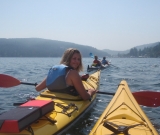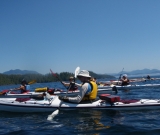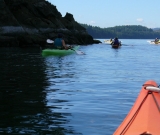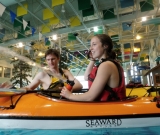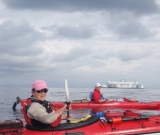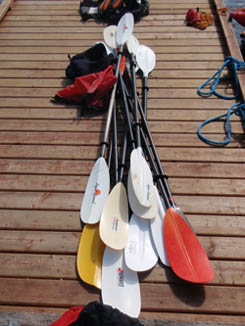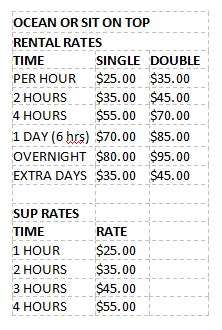By Wayne Horodowich
I realize everyone has his or her own perspective on just about every issue. One of the prevailing opinions I don’t agree with is “never paddle alone”. Every time I hear an instructor tell their students “never paddle alone” I am hoping they would add a condition onto their statement but most of the time the warning just stands alone. I believe a blanket statement discouraging paddling alone is a disservice to paddlers.
Personally I love paddling alone. I know of a lot of kayaker’s that paddle alone. In fact I encourage paddlers to learn to paddle alone but I add conditions to my statement. I am not suggesting that you take a rank beginner and say “go and paddle on your own”. However, I do tell my beginning students that they should not start paddling alone until they can meet a list of conditions. By taking this approach I am educating my students on what they need to know before they undertake an endeavor rather than eliminating even the possibility. To tell paddlers “just say no” to paddling alone is not being proactive.
I believe there are excellent reasons why a kayaker should work towards paddling alone. One of the basic tenets I teach to guides and instructors is, “the strength of the group is based upon the strengths of the individuals in the group.” By paddling alone I have learned self-sufficiency. I know every aspect of the paddle is my responsibility. If anything goes wrong I will be responsible for dealing with it. I need to know where I am at all times. I need to self-launch and self-land. The greatest reward of solo paddling is not a measurable skill. It is a change in attitude. The increase in self-confidence alone is worth it. I believe that solo paddlers have a greater sense of awareness. Give me a paddling partner with greater awareness and higher self-confidence any day of the week. However, they will not get that same awareness and self-confidence if they always paddle with me or in a group.
This leads me to listing what I think a paddler should know, be able to do and need to have if they wish to paddle alone. Dressing for immersion, always wearing your PFD, having your own paddle float and pump are givens whenever you get on the water whether alone or in a group.
Before you paddle alone be sure you have the following:
- Reliable self recovery skills
- Solo launching and landing skills
- Directional awareness (navigation)
- Spare paddle
- Signaling kit (with vhf radio &/or cell phone)
- Repair kit
- Familiarity with the route (when beginning solo paddling)
- Knowledge of expected weather conditions (listened to most recent marine forecast)
- Float plan filed with friends (including a call when off the water.)
The equipment suggested is equipment you will probably be carrying with you even on group trips. The skills can be learned and practiced on group trips. Once you feel you are ready then start with a half-day trip in an area that you have paddled before. As your comfort zone increases and your skills become second nature your boundaries will extend farther and farther. Look at Ed Gillette. He did a solo trip to Hawaii from California.
Before you jump in your kayak and paddle off into the sunset (or the sunrise for you East Coast paddlers) be fully aware of the risks and potential consequences of paddling solo. Alone means alone. If something happens you need to have the skills and attitude to deal with it. If you go out with the belief “If I get into trouble I will just call for help”, then you are missing the point. Rarely should there ever be an instance where you need to call for help. Being prepared and being aware of the environment eliminates the vast majority of mistakes made by the sea kayakers who do end up calling for help. The most risky part of paddling alone is the sudden illness that can occur (heart attack, seizure, blackout, etc…) which could render you helpless and unable to make the call. The risks can be higher if you are alone. Keep in mind that paddling alone can be peaceful but there are times it can be lonely.
The other side of the coin is the rewards from paddling alone. There is a great feeling of accomplishment. You are learning to rely on yourself, to trust yourself and your decisions. The motivation to learn and practice is greater because the potential consequences seem higher. The peace and quiet when paddling alone is a wonderful way to center yourself.
One last consideration is the false sense of security that one may have when paddling in a group. Just because there is a group does not mean there is safety in numbers. In the event you capsize while in the group are you sure those in the group will come to your aid? If they don’t help because of inadequate skill level or anxiety in difficult conditions your own self-sufficiency will be your salvation. It can be said that a kayaking group is a collection of solo paddlers.
As I said earlier, I love paddling alone. I could not have gotten to my current skill and experience level if I only paddled with others. I am also willing to take the consequences of paddling alone. I trust my judgment and my skills, which have both been increased by paddling alone. Therefore, I say, “before you paddle alone, it would be in your best interest to meet the criteria mentioned above”.
